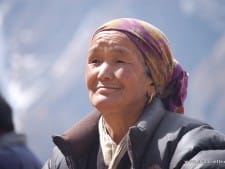 I often say that a trek in the Khumbu will change your life. Today, April 7, 2014, there are hundreds, if not thousands of climbers, trekkers, and local people on the dirt trails of the Solo Khumbu region of Northern Nepal.
I often say that a trek in the Khumbu will change your life. Today, April 7, 2014, there are hundreds, if not thousands of climbers, trekkers, and local people on the dirt trails of the Solo Khumbu region of Northern Nepal.
Some are going to attempt Everest others simply to visit base camp, regardless, many may experience a profound change in their life.
My first trek was in 1997. I didn’t know what I didn’t know at the time and was in for a change.
Arriving in Kathmandu, you experience culture shock with the noise, poverty, traffic and general chaos so it is a relief when you board a Twin Otter at the airport for the flight to Lukla. It is during this flight that the hints emerge that you are leaving the world you once knew for something entirely different.
Leaving Lukla for the short hike to Phakding begins your transformation. There are no paved roads, no cars, few power lines. You share the trail with everyone and everything. It is a simple world filled with people living a simple lifestyle. So you think.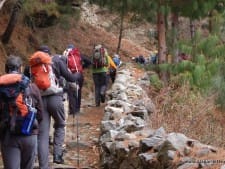
In the distance you hear hammering and voices. As you approach you see a new house being built. The stone walls are forming the outside structure. Men with simple chisels and hammers are creating perfectly formed blocks that fit together as if molded from the world’s finest kiln. The men are speaking in quiet tones as they work. Their work is not simple.
In the fields you see women bent at the waist tending to potato crops or perhaps it is buck wheat. Their lavender colored dresses blow in a soft breeze. A cow grazes nearby tied to a stake in the ground. Two children play near the women.
Your first night in a teahouse reveals a sophistication you never will understand. Your supper is simple but amazingly good. You want seconds but don’t want to be greedy. You are learning.
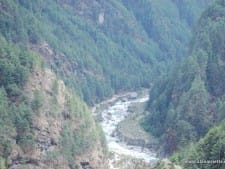 The next stop is the capital of the Khumbu, Namche Bazaar. The hike from Phakding took a toll on you, Even though you climbed a long, steep hill; it is nothing like the original Namche Hill that was longer, steeper and hotter according to the locals who smile and laugh easily at the sweat on your forehead. They are laughing with you, not at at you, acknowledging the work it takes to live here.
The next stop is the capital of the Khumbu, Namche Bazaar. The hike from Phakding took a toll on you, Even though you climbed a long, steep hill; it is nothing like the original Namche Hill that was longer, steeper and hotter according to the locals who smile and laugh easily at the sweat on your forehead. They are laughing with you, not at at you, acknowledging the work it takes to live here.
Namche is a town of prosperity. New building, new wells, electricity; even an ATM, bank and dentist. The huge Stupa on the outskirts of town welcomes everyone but reminds you that Buddha is always watching.
Leaving Namche, you feel that each step is taking you further away from something old and closer to something new. The roads, ah, trails, are a bit wider as you traverse the high hills overlooking the Dudh Kosi River. You can hear the rushing water even though it is thousands of feet below you. The river has no traffic, too rough, too aggressive for travel. It is simply a conduit for the melting snows of the high Himalaya.
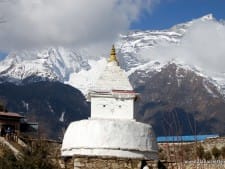 You pause to look when you hear more voices, children laughing. A small gaggle runs by dressed in clean uniforms with white shirts. “Namaste!” they shout at you with a huge grin. Your reflexes take over with an equally loud greeting and smile. Your shoulders relax as your pace lessens. The transformation continues.
You pause to look when you hear more voices, children laughing. A small gaggle runs by dressed in clean uniforms with white shirts. “Namaste!” they shout at you with a huge grin. Your reflexes take over with an equally loud greeting and smile. Your shoulders relax as your pace lessens. The transformation continues.
Passing through another village you see more children playing, with sticks, perhaps a jump rope. Their laughter is contagious. They seem happy. They are kids being kids.
This pattern continues over the next several days. You see mountains you have only read about, Ama Dablam, ‘Mother’s Jewel Box’, towers over the Khumbu. You stare in amazement at the Dablam seemingly glued near the summit. How does it stay there, when will it fall? You look around and wonder how long this area can remain as it is, when will it fall?
Visiting the monastery in Tyengboche opens your eyes to yet another new world. Sitting crossed legged on a Tibetan rug, it is cold. The room is dark with filtered light struggling to enter the old glass panes. Soon the monks enter, they have a light heart about them. They take their places on small wooden benches also covered with Tibetan rugs. The Monks’s crimson robes look heavy, no, they look warm as you pull your down jacket tighter.
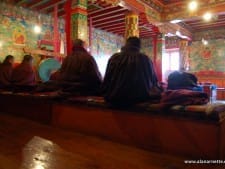 The prayers begin as the drum set a rhythm. A monk chats continuously, without pause, without breathing. You soon enter your own trance, feeling calm and relaxed. You feel warm now. Just as you drift away, a loud, huge, clanging begins. The young Monk beats the two copper cymbals together with unedited enthusiasm, the drum beats harder. You are brought back to reality.
The prayers begin as the drum set a rhythm. A monk chats continuously, without pause, without breathing. You soon enter your own trance, feeling calm and relaxed. You feel warm now. Just as you drift away, a loud, huge, clanging begins. The young Monk beats the two copper cymbals together with unedited enthusiasm, the drum beats harder. You are brought back to reality.
As the journey goes further towards Tibet and Everest the landscapes changes. No more trees, no more long rushing rivers. Now only small streams accompany the trail. But the mountains remains. Oh the mountains. Ever higher, snow covered. Glaciers define the eons of snow melt.
The village names run together: Periche, Dingboche, Dugia, Lobuche. They look similar but each has it’s own personality. As much as you enjoy the walk, the teahouse lunches are a . Pulling into a village at the end of the day, you look around, taking it all in.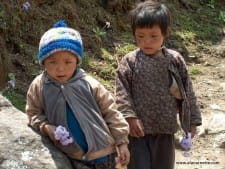
Your tiny room has enough space for two single beds. The room is dark and cold. You take out the sleeping bag to let it regain the lost loft. You sit on the bed letting you body regain it’s loft.
You are satisfied. No need for anything other than what you have.
The transformation continues.
Climb On!
Alan
Memories are Everything

16 thoughts on “Everest 2014: The Trek that will Change Your Life”
The only words I can think of is “thank you” Alan. You are also making me more determined to get there in 2017!
Great Story. Please consider writing a book – maybe a compilation of Everest reports combined with beautiful articles like this one, I will it!
Thanks John for your thoughts.
I did the trek last year in February, it was a life changer. I need to get back. I have one regret from the time, is that at times I “rushed” it. I didn’t take the time to always drink it in and totally live in those moments.
For three weeks after getting home, I dreamed of Everest and Khumbu every night!!
Thank you Alan–When you have time, would you carry on the narrative to Kala Patthar? What’s it like to climb that “small” prominence to get the classic view of Everest?
Excellent synopsis of the trek from Lukla to Base Camp via Tengboche. In fall of 2012 our trek followed slightly different route up – Phortse – and regular route back. Was glad I was going down from Tengboche vs going up like so many others. Only wished I’d known the importance of a buff and wearing it, even in Kathmandu.
Q: Anybody done the 3 passes trek which includes a night at Base Camp? It looks like a decent objective for next year.
Thank you Alan–More, please. When you have time, would you carry on the narrative to Kala Patthar? What’s it like to climb that “small” prominence to get the classic view of Everest?
Not wanting to hog the reply but Kala Pathar was a major highlight of the entire trek and absolute “must do.” We climbed KP in the afternoon, quite breezy and downright cold but unforgettable view of the Big E.
BTW: Conrad Anker’s latest book, THE CALL OF EVEREST, coffee table size, has outstanding history/maps/photos of Everest.
Thanks, and I’ll put the book on my wish-list.
I AGREE WITH JOHN! Watching and hearing the YAKS and seeing the backdrop puts this armchair adventurer into the emotional early stirrings of the summit quest.
All so so true! 🙂 thank you Alan!
You’re captured the feelings one has whilst in the Khumbu region perfectly – a really good piece & thank you for taking me back to February 2012 :¬)
I sm transported back to EBC and cannot wait to do it again next year….new vistas and challenges calling.
Superbly written…
You put me in a trance reading this, Alan. It is so easy to go back (in my mind) to the time that I had the privilege to do the trek to EBC. Truly the Adventure of a lifetime! Thank u for making it so real again!
Hi Alan, it looks great and am thinking about next year doing a trek around the Everest region, although the Lukla flight scares me a bit. I would like to get to EBC. However, I have done a little research and what I have come up with is that the view from the Tibetan North side EBC of Everest is much better than the Nepal side EBC. Any thoughts on this would be most appreciated. Jacqueline
No need to think, just do it, it’s awesome, as for the north side I think you can drive all the way to it, which I feel would kill the feelings/emotions you get from the trek
Just my thoughts
Comments are closed.